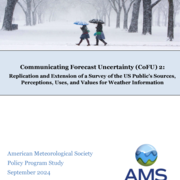Executive Summary (excerpted)
In the 2021 AMS White Paper “Weather-Water-Climate Value Chain(s): Giving VOICE to the Characterization of the Economic Benefits of Hydro-Met Services and Products” (Lazo and Mills 2021) present the weather information value chain (see Figure ES-1) and emphasize that “It is within the context of information improving, reinforcing, or changing the decisions of end-users, that economists would argue there is actual or potential economic value to this information” (p. 4). Thus, understanding end-users’ sources, perceptions, uses, and values of weather information is critical to the Weather Enterprise’s efforts to “to deliver the most accurate, most timely, most relevant weather information to all 330 Million Americans.”
In 2006 the research team of Julie Demuth, Jeff Lazo, and Rebecca Morss from the National Center for Atmospheric Research (NCAR), and Alan Stewart of The University of Georgia designed and implemented a survey of the general public of the United States to explore a range of issues related to the communication, use, understanding, and value of weather forecasts. This resulted in five published articles including Lazo et al. (2009).
In 2022, with support provided by the Policy Program of the American Meteorological Society (AMS), which is under the direction of Paul Higgins, we reimplemented essentially the same survey. To the maximum extent possible the exact same survey instrument, implementation methods, and target population were replicated. Five additional topics were included at the end of the instrument to begin to assess these related concepts (cultural risk theory, numeracy, perceived vulnerability, political preferences, and risk preferences).
The current report focuses mainly on analysis related to the topics from the Lazo et al. (2009) paper (“300 Billion Served”), which covered questions related to the sources, perceptions, uses, and value of weather information (i.e., not the decision scenarios or the communication of uncertainty questions included in the survey). In this report we also document our survey design and implementation methods.
